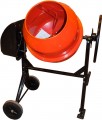Finished mixture capacity
The largest volume of mortar that can be prepared in a cement mixer at a time. Since the mixing process according to the most common gravity technology (see "Mixing type") involves an inclined position of the drum, it cannot be filled to the brim — the contents will simply pour out. Accordingly, the volume of the finished mixture anyway will be less than the total volume. The latter is also true for forced-type aggregates.
When evaluating a model with gravity mixing by the volume of the finished mixture, it must be taken into account that due to the shape of the drum, this volume cannot exceed 2/3 of the total capacity — for example, for a cement mixer with a drum of 120 liters, it will be about 80 liters. If the manufacturer indicates higher figures, then it is likely that we are talking about the theoretical amount of concrete that the engine and drive can twist in the drum without problems. This is a good indicator of reliability, but it is far from a fact that just such an amount of solution at a time can be prepared in fact.
Anyway, this parameter also plays the role of a limiter: you cannot load the cement mixer in excess of the volume of the finished mixture claimed by the manufacturer. Yes, it is likely that such a quantity of ingredients will fit in the drum, the device will not break immediately and even be able to work stably for some time. However, the mechanisms of the cement mixer in this mode will experience increased loads, which can lead t...o their premature failure; and such cases are not covered by the manufacturer's warranty.
Drum/blade speed
The speed at which the drum or blades (depending on the type of mixing, see above) move during operation of the cement mixer. In most consumer-class models, this indicator is more of a general reference than practically significant — the optimal speed for solutions that such devices usually have to work with is about 23-28 rpm, and the vast majority of models fit well into this range. The differences between specific values, usually, are completely uncritical and are due to the difference in the size of the drums and the power of the engines.
Max. power
The power of the motor used to rotate the working mechanism of the cement mixer. This parameter can be called secondary, because. it is selected depending on the volume of the drum (see above) — in such a way as to ensure rotation without problems at the maximum working load (see "Volume of the finished mixture"). And the main criterion when choosing a cement mixer is still the volume of the drum. However, models of equal volume may vary in power, and to determine the optimal option, it is necessary to take into account the planned operating conditions.
So, the "ceiling" in terms of power for small cement mixers with a volume of up to 130 liters, designed for use in individual construction, is 700-800 W — this is quite enough for normal operation without excessive electricity costs. If you need continuous operation for 10 hours or more, you should pay attention to more powerful models. It is also recommended to have a power reserve if the cement mixer has to be used with unstable networks where voltage drops are possible.
Drum tilt lock
The device fixing the drum affects the principle and convenience of unloading the finished mixture from the cement mixer.
—
Manual. Manual swivel wheel in the design of a cement mixer. To unload the mixture, it is necessary to pull it towards you, after loosening, turn the drum to the required angle of inclination of the cement mixer, and release the wheel. The load in this case falls on the hands.
—
Foot. The rotary wheel for adjusting the angle of the drum in the design of the foot lock is supplemented with an L-shaped pin or pedal, the protruding part of which is pressed by the foot. The advantage of this solution is that in order to loosen the mechanism for fixing the drum, force must be applied to pressing the "poker", and there is a minimum load on the hands.

